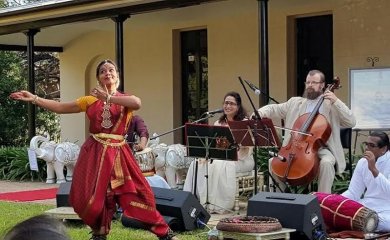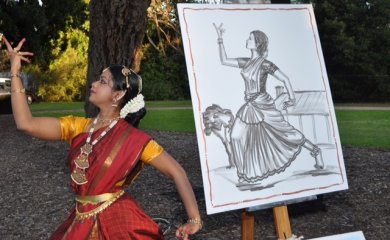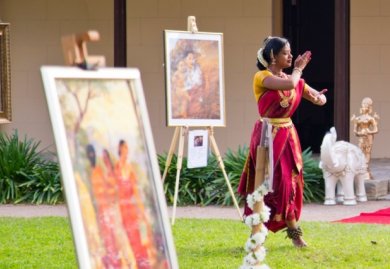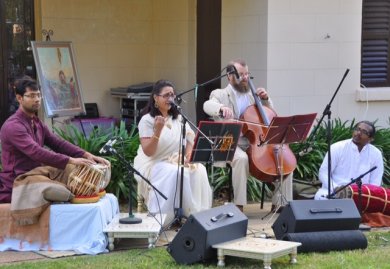
|   |

|   |
The Dreaming Damsel - Saroja Srinivasan May 24, 2015 It was a balmy Sydney autumn Saturday afternoon. Blue skies above and the sun was shining after a week of inclement weather. It was in the grounds of the Hambledon Cottage in Parramatta, that we were transported to a dream world. Built as John Macarthur’s residence in the mid-1840s, this cottage furnished with period furniture depicts early settlements and the life style. Around this time, Raja Ravi Varma, a well known painter was born in India in 1848. The combination of the two disparate historical occurrences from the mid 1800s evoked the unique ambience of the times and inspired this delightful confluence of art forms, history and cultures. In this setting, Sydhwaney Productions presented a multi art form presentation with a group of ‘new settlers’ from the Indian sub-continent along with an Aussie cellist. “The work sits on the edge of theatre, combining the Australian heritage environs with visual and performing arts. The story telling poetic, musical and richly visual - this is one show where the audience cannot close its eyes and listen,” says Sumathi Krishnan. 

Under the shade of a 300 year-old tree, with the distinct crown of thorns roof of the Anglican Church next door peeping though the tress, as they gently sway in the cool breeze, the audience was treated to a delightful presentation of a creative combination of art forms. Quite incongruous at one level, yet inspirational. Sumathi Krishnan who created and manages the web site, Sydhwaney, that covers the Indian Arts scene in Sydney and whose ‘dream’ it was to present this multi-art form presentation, was the vocalist. Her melodious voice illustrated the various emotions excellently. John Napier on the cello was brilliant in his accompaniment as well as the solo piece. He showed his expertise of the instrument adapting to the Indian ragas masterfully. Aruna Gandhi, the young dancer’s bhava of the lyrics was the perfect compliment. Aruna moved gracefully from vibrant to the poignant in her portrayal of the emotions with ease and confidence. The percussionists, Pallavarajan on the mridangam and Abhijit on the tabla, were worthy accompanying artists. Murthy Anjanappa, the artist added a delightful finale by creating art pieces that depicted the themes of the lyrics including one of the dancer in her last lingering pose, to the accompaniment of their vibrant drums. Anu Shivaram and Rekha Rajvanshi’s poems in Hindi and English kept the evocative theme going and added flair to the artworks of Raja Ravi Varma’s paintings that were exhibited on the green lawn. Artistically developed by Sumathi Krishnan, Aruna Gandhi and John Napier what was most appealing and etched in the minds of many in the audience were the choice of pieces. The choice of ragas for each of the items was apt and added to the emotive experience of the afternoon. Each of them was distinct, from Yaman as the opening raga, to Basanthi for the Bhagavatham piece. This was followed by the popular Adharam madhuram in raga Mohanam. The first, Mohe apne hi rang meh rang le (Colour me in your colour), a vocal piece by Sumathi Krishnan set the scene. Amir Khusrao’s lyrics and the poignant emotion in Sumathi’s voice added to the song in the raga Yaman. This was accompanied by John Napier’s poetic recitation of the sadness felt by King Dushyanta when he meets Shakunthala, many years after they first met, from the evergreen love-story by poet Kalidasa. The emotion in conveying the beauty of the Lord in everything around us was beautifully revealed by the verses from Vallabhacharya’s Madhurashtakam ably portrayed by Aruna in raga Basanthi. The poetry of Rumi set in raga Madhuvanti sung by John Napier followed by his own free-flowing composition of the Dhrupad and Khayal kept the magic of the dream going. Verses from the famous 9th century South Indian Tamil epic text of 4000 verses, Divya Prabhandam, illustrating the dreams of Sri Andal came to life with the dance choreographed and danced by Aruna Gandhi. This was in Ragamalika, composed by Sumathi Krishnan, interspersed with swarams to the accompaniment of the mridangam. To the rhythmic sounds of mridangam and tabla, the artist Murthy Anjanappa depicted in a painting the scene of Ganga descending to earth through the dreadlocks of Lord Shiva. The finale, thillana in raga Chandrakauns with the vibrant and sometimes sublime movements of Aruna aptly concluded the performance. This presentation was refreshingly different and evocative of the emotions and similarities of the old and new cultures with no barriers of language or place or art form. The ladies in the period costume added a nice touch to the whole presentation. 

In Sumathi’s words: “Under the tall trees that bear witness, the painter’s brush moves, the bow of the cello draws on a melody, the beat of the percussion follows the footsteps of the statuesque dancer, as a voice of the poetry embraces you on a journey of the Dreaming Damsel.” Brian Powyer, the President of Parramatta Historical Society attended the performance. His commendation says it all. “…impressed by the scope and diversity incorporated into the production. The quality and intensity of all performers was both compelling and outstanding. The decorations and props transported the grounds and building to another place and added to the genuine mystique and romance of the story. A thoroughly masterful performance.” “Do dreams just happen? What makes them come true? The musician…the poet…the dancer…the painter… would we be here, if we didn’t dream?” It certainly took us on a remarkable journey, or was it a dream? |